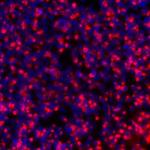
Research Topics
Developmental Signal Transduction
Cell-cell adhesion maintains intercellular connections between neighboring epithelial cells for normal morphogenetic movements during development. Disruption of this critical process is also one of the earliest steps in metastatic progression of cancer cells. Our laboratory has focused on providing mechanistic insights into how the Eph/ephrin signaling system affects cell-cell interactions; specifically, how the ephrinB transmembrane ligands send signals affecting cell-cell junctions, adhesion, and cell movement. This signaling affects morphogenesis during development, as well as tumor cell invasion in the disease state. We often employ the Xenopus system since we have found it to be a powerful tool for understanding the contribution of several signaling molecules to developmental and cellular processes. Thus, Eph/ephrin and Wnt/Planar Cell Polarity signal transduction can be assessed morphologically, histologically, as well as biochemically in a developing vertebrate. Although the bidirectional signaling between ephrinBs and their receptors is quite complex, it is clear that control of the expression and interplay between these proteins may have important effects on malignant transformation and metastatic progression. Our future direction is aimed toward a mechanistic understanding of the cross-talk between the Wnt and Eph/Ephrin systems; using an interdisciplinary approach to research by integrating the use of biochemical and developmental techniques to further our studies.
Biography
Selected Publications
- Gaur S, Mandelbaum M, Herold M, Majumdar HD, Neilson KM, Maynard TM, Mood K, Daar IO, Moody SA. Neural transcription factors bias cleavage stage blastomeres to give rise to neural ectoderm. Genesis. 2016;54(6):334-49.
- Ji YJ, Hwang YS, Mood K, Cho HJ, Lee HS, Winterbottom E, Cousin H, Daar IO. EphrinB2 affects apical constriction in Xenopus embryos and is regulated by ADAM10 and flotillin-1. Nat Commun. 2014;5:3516.
- Cho HJ, Hwang YS, Mood K, Ji YJ, Lim J, Morrison DK, Daar IO. EphrinB1 interacts with CNK1 and promotes cell migration through c-Jun N-terminal kinase (JNK) activation. J Biol Chem. 2014;289(26):18556-68.
- Lu Q, Insinna C, Ott C, Stauffer J, Pintado PA, Rahajeng J, Baxa U, Walia V, Cuenca A, Hwang YS, Daar IO, Lopes S, Lippincott-Schwartz J, Jackson PK, Caplan S, Westlake CJ. Early steps in primary cilium assembly require EHD1/EHD3-dependent ciliary vesicle formation. Nat Cell Biol. 2015;17(3):228-240.
- Hwang YS, Lee HS, Kamata T, Mood K, Cho HJ, Winterbottom E, Ji YJ, Singh A, Daar IO. The Smurf ubiquitin ligases regulate tissue separation via antagonistic interactions with ephrinB1. Genes Dev. 2013;27(5):491-503.
Related Scientific Focus Areas
This page was last updated on Thursday, November 2, 2023



